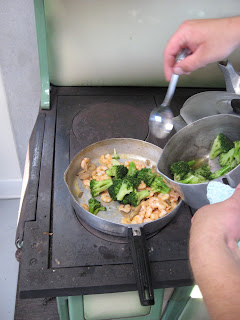Plan B was what I call cheating because it was a combination of ready-made foods. Hey, it happens sometimes!
The reason that I want to include these cheating recipes on the blog, though, is to drive the point home that cooking on a wood cookstove doesn't necessarily mean that every meal is going to take an eternity of prep time. I read somewhere that cooking on a wood cookstove tends to draw people toward cooking meals that generally take more time than usual just because of the nature of the stove. This may be true, but it doesn't have to always be that way. My approach to living with a wood cookstove is that I want this beast in the kitchen to do what I want it to do, and occasionally that means that I need a meal in a hurry.
If you start with a cold stove, the meal in this post can be completed in less than an hour. If the stove is already going before you start, this meal could be complete in about a half hour.
With a hot fire in the firebox, I start with my pans arranged in the manner that you see above. The large pot in the back is water coming to a boil for the pasta. The saucepan to the right has about a half inch of water boiling in the bottom to steam broccoli. The frying pan in the front has a couple tablespoons of butter melting in it to saute the shrimp and mushrooms. Once again, the coffee pot and teakettle are filled with cold water to just absorb extra heat since our summer days are still climbing into the nineties with high humidity.
I add a good two cups or so of uncooked bowtie pasta to the boiling water. I'm sorry about the vague measurements; I'm just that sort of cook. You'll have to be patient with me.
If I were a good Italian, I suppose that I would have added a little olive oil and salt to the water. You can feel free to do so, but I'm not a good Italian. I'm not even a bad Italian. I'm mostly German, but that has nothing to do with anything.
I tend to not salt much while I'm cooking because my mother didn't salt much when she cooked. Furthermore, since there is a purchased jar of alfredo sauce coming up, I can depend on it to have plenty of sodium for me. I also figure that people can salt their own plates at the table so that they get the flavor that they desire.
I then put a lid on the pasta. This may seem like a gratuitous picture, but I want to take this opportunity to talk about the importance of lids while cooking on a cookstove. When I'm cooking on an electric or gas stove, I usually use lids because of the energy savings that they afford. The same is true on the cookstove. Since a wood-fired range generally provides a less intense heat than a gas or electric range, the lids can help ensure faster cooking. The other reason that I am a proponent of using lids on a cookstove is because sometimes it is necessary to add fuel to the fire while you are cooking. I tend to feed the fire through the front top lid, and occasionally small pieces of bark, splinters, dirt, or fly ash will land on the cooktop as a result of this. The lids make sure that none of this debris lands in your food.
Just being honest here, folks.
I can hear my mother's voice right now, saying of the debris (of the skinned knee, of the bug you accidentally swallowed as you were walking up to Gramps and Gran's, of the manure you fell into, etc.), "It won't kill you." She's right; it's not a big deal, but I want to be a clean cook.
I put frozen cooked shrimp into the butter to begin cooking. I think that we put about two cups in this batch because we are shrimp lovers.
Once the shrimp was thoroughly heated and the broccoli had steamed long enough to be hot, I scoop the broccoli out of the water and put it in with the shrimp and mushroom mixture.
Then I poured in a jar of alfredo sauce. You can use homemade alfredo sauce at this point, too. Do what you want here.
I let this cook together, stirring occasionally, until the pasta is finished cooking. Usually, this is only a few minutes.
I put a bed of pasta on a plate, and pour some of the shrimp alfredo mixture over the top, and supper is served.
 |
| Shrimp and broccoli alfredo, a quick wood cookstove meal. |
Shrimp and Broccoli Alfredo
2 good cups uncooked bowtie pasta
2 T. butter
2 good cups frozen cooked shrimp
1 can mushrooms, whatever size you want
1 jar alfredo sauce, or about a pint homemade
2 cups frozen broccoli
1. Bring sufficient water for cooking pasta to a boil. Add pasta to boiling water and reduce heat to simmer.
2. Saute shrimp and mushrooms in butter.
3. Steam broccoli in about a half inch of water until hot.
4. Remove broccoli from steaming water and add to shrimp and mushroom combination.
5. Add alfredo sauce to shrimp and broccoli and let cook together until pasta is finished cooking.
6. Drain pasta.
7. Place a bed of pasta on each plate, pour shrimp alfredo mixture over the top.
Yield: Four servings.









This recipe looks VERY good! I imagine I could adapt this recipe to a low carb meal by making my own Alfredo sauce and eliminating the pasta. Thanks!
ReplyDelete